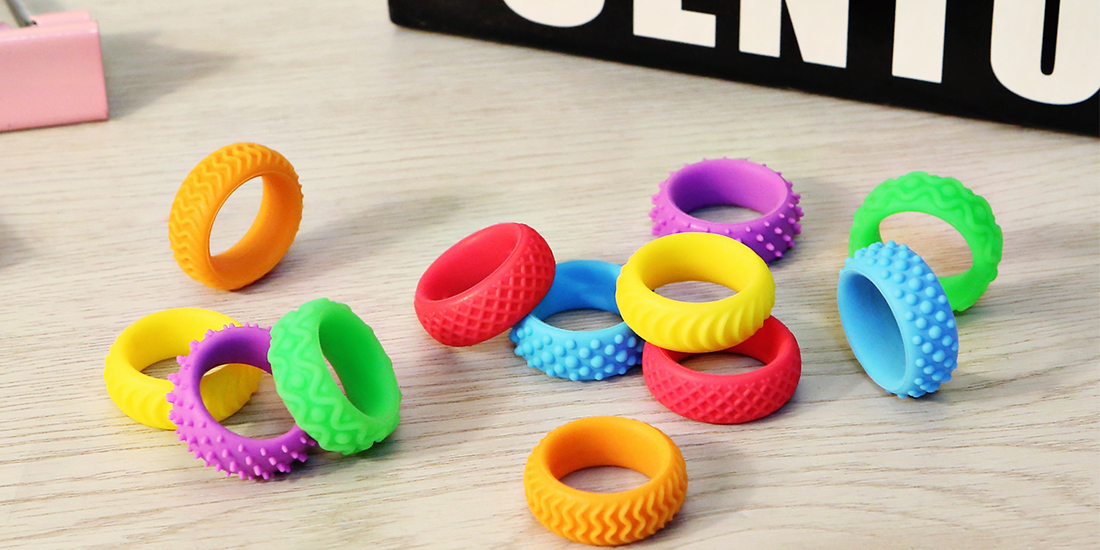
What are Sensory Rings? Different Materials: Pros and Cons
Sensory rings, also known as fidget rings or anxiety rings, are wearable tools designed to provide sensory input that helps reduce anxiety, improve focus, and soothe restlessness. They work by engaging the sense of touch through various textures, movements, or pressure points on the fingers, which can distract the mind from anxious thoughts and bring the wearer back to the present moment. These rings have gained popularity not only among people with anxiety but also those with sensory processing disorders such as ADHD and autism, as well as individuals experiencing dementia-related agitation
What Are Sensory Rings?
A sensory ring is typically a ring designed with tactile features—such as spinning bands, textured surfaces, or flexible materials—that invite the wearer to fidget with it. The repetitive motion and sensory stimulation help interrupt cycles of anxiety by shifting focus away from stressful thoughts to physical sensations. Some sensory rings also incorporate acupressure by applying gentle pressure to specific points on the fingers, which may promote relaxation through nerve stimulation.
In essence, sensory rings serve as discreet, portable anxiety tools that can be worn throughout the day, offering a subtle but effective way to manage stress and sensory overload.
Different Materials of Sensory Rings: Pros and Cons
Sensory rings come in a variety of materials, each with unique advantages and disadvantages depending on the wearer’s needs, comfort, and lifestyle
Stainless Steel
Pros:
- Highly durable and scratch-resistant, making it great for everyday wear.
- Hypoallergenic for most people, reducing risk of skin irritation.
- Affordable compared to precious metals.
- Low maintenance and easy to clean with soap and water.
Cons:
- Heavier than some other materials, which might be uncomfortable for sensitive fingers.
- Cannot be resized, so sizing must be accurate.
- Although durable, it can still scratch over time.
- Not flexible, so less forgiving if fingers swell.
Rubber
Pros:
- Flexible and comfortable, adapts well to finger movement.
- Lightweight and inexpensive.
- Provides good grip and tactile sensation.
Cons:
- Less durable, prone to wear and tear or breaking.
- Can absorb sweat and dirt, requiring frequent cleaning.
- May cause skin irritation for some people with sensitivities.
Silicone (Food-Grade)
Pros:
- Extremely flexible, soft, and comfortable to wear even during finger swelling or arthritis flare-ups.
- Hypoallergenic and safe for sensitive skin.
- Breakable in emergencies, which is a safety feature.
- Sweat-resistant and easy to clean.
- Can be made with multiple textures to enhance sensory input.
- Some silicone sensory rings are chewable, adding an oral sensory dimension that’s great for those who seek additional calming input. (NPPN Sensory Rings)
Cons:
- Less durable than metal rings; can tear if snagged
- May attract dust or lint due to soft texture
- Not as visually traditional or "jewelry-like" as metal rings
Why Choose Our Brand’s Sensory Rings?
NPPN sensory rings are crafted from food-grade silicone, ensuring they are safe, durable, and comfortable for all-day wear. Unlike typical rings, our products feature multiple textures, providing varied sensory input that can help calm nerves and improve focus. They are also tear-resistant, meaning they stand up better to daily use and fidgeting. Plus, our rings are chewable, a unique benefit for those who find oral sensory input soothing—making them perfect for people with sensory processing needs or anxiety.
If you’re tired of fiddling with boring stress balls or bulky gadgets, our sensory rings are the perfect blend of function and fun. They’re discreet, stylish, and designed to keep your fingers busy so your mind can take a break. And hey, if you find yourself spinning the ring so much you get dizzy, just remember: at least you’re not spinning your wheels in anxiety anymore!
